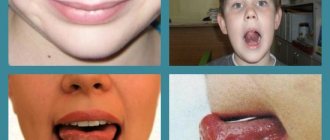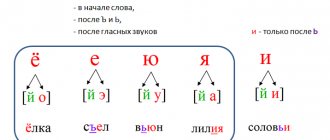Phonemic hearing is directly related to physiological hearing, that is, to the innate ability to hear various sounds of the outside world. The difference between them is that the first one helps not only to hear, but also to analyze information. Phonemic perception in speech therapy is a narrower concept that includes distinguishing by ear the main parts of a word (syllable, sound), differentiating speech and non-speech sounds, determining the strength and timbre of the voice and much more. If the perception of phonemes is not formed for a number of reasons, then a violation of the syllabic and sound components of the language occurs.
Formation of phonemic awareness/hearing
In a preschool institution, work on the formation of the phonemic aspect of speech is carried out gradually, starting from an early age. But the development of phonemic hearing up to one year can be considered a fundamental stage:
- Already at two months of age, the baby, with normal development of physiological hearing, distinguishes the mother's voice.
- By three months of age, the baby determines where the sound is coming from and turns its head towards the stimulus.
- After another month, he already shows a reaction to the expressiveness of speech (the strength and intonation of the voice); he may be afraid of a loud sound or scream.
- At 5 months, humming is replaced by babbling. Six-month-old children with normal development listen carefully to the conversation, repeat sounds or direct open syllables after the adult.
- By eight months, the child begins to use only the sounds present in his native speech.
The correct development of phonemic hearing at 1-2 years will be evidenced by the child’s understanding of the adult’s speech addressed to him. In this case, it means following simple monosyllabic instructions (for example: “give me the car”, “bring the doll”), correctly understanding basic questions (“where is daddy”, etc.). With normal intelligence, by the age of three, phonemic hearing is almost formed, the baby distinguishes and corrects incorrect speech.
Correction of violation
To develop phonemic hearing, first of all, regular classes with a speech therapist are needed. Our center also successfully uses the Tomatis method of neurosensory auditory stimulation to improve auditory-verbal and phonemic perception. Listening to a special program using bone conduction headphones expands the range of frequencies perceived by the brain, including those at which the temporal cortex recognizes speech sounds. Auditory-verbal attention also improves.
During speech therapy sessions, our center’s specialists use a Forbrain headset, which also has bone conduction and special dynamic filters. With the help of this device, a child with phonemic hearing impairment begins to hear his mistakes and can correct them. With regular practice with Forbrain, speech improves, its fluency, pronunciation, rhythm and musicality, auditory discrimination and memory.
Correction of FFNR should be carried out comprehensively. A speech therapist conducts classes, and a neurologist prescribes therapy aimed at eliminating problems in the functioning of the nervous system (normalizing the functioning of blood vessels, nourishing the brain, etc.). In addition to classes with a speech therapist, parents should work with their child at home. To do this, the specialist gives homework.
Phonemic awareness and hearing disorders in children
At primary school age, problems in the development of phonemic hearing and perception can be expressed not only in children’s oral speech, but also in written speech. This is evidenced by such violations as:
- Replacement, rearrangement or omission of individual letters in a word, sometimes entire syllables (porridge - kafa, ksha, aksha, etc.).
- Failure to pronounce words (toy - toy).
- Separation or merging of words when writing (in the forest - in the forest, train - on the train, etc.).
- Skipping a soft sign or, conversely, softening where it is not required (skates - skates, wound - wound).
- Semantic distortion (drying - ear, button accordion - ram).
The same thing happens when reading. Children with FPD (phonetic-phonemic disorder) often cannot merge sounds into syllables, and syllables into words: they read in a set of letters, change places, and do not read to the end. All this leads to difficulties in further education, as a result of which children begin to lag behind their peers.
LEVELS OF SPEECH PERCEPTION
Speaking about phonetics, there are two levels of speech perception.
| Phonemic (sensorimotor) level | Phonological (linguistic) level |
| This is the ability to distinguish speech sounds by ear and produce them through articulation. In essence, this is the general sound of speech. | Speech recognition at the phoneme level. The ability to determine the sound sequence and number of sounds in a word. |
The speech that a child hears is a rather difficult and unstable sound process. The child’s task is to find sounds and sound connections with the help of which one can distinguish the meaning of what is being said.
But the child must also be able to generalize speech sounds, this is called the semantic role of language.
Causes and mechanisms of violations
In order to eliminate the problem, you need to know the causes of its occurrence. Delay or impairment of phonemic hearing and perception is not just pedagogical neglect, although this option may be appropriate.
The mechanisms of occurrence can be started even in intrauterine development. Therefore, it is necessary to know the root cause, since it is this information that will allow us to determine methods of working with the child: speech therapy assistance alone is not always enough; in some cases, drug treatment is also necessary.
The main causes of FFN in children include the following:
- Pathological changes in the ontogenesis of the fetus during the period of intrauterine development of the speech zones of the cerebral cortex or the formation of speech organs. This is especially pronounced in cases of disturbances in the structure of the articulatory apparatus, when a child is born with a gothic palate, cleft lip, cleft palate and other pathologies.
- Birth injuries, this also includes fetal asphyxia, incorrect position of the forceps at the moment when the doctor directs the fetus, prolonged, complicated labor. As a result, the functioning of speech centers may be disrupted.
- Viral, somatic or infectious diseases suffered in early childhood.
- Social factors contributing to the development of FFN: neglect, psychological trauma, fear, an unfavorable environment for speech development (parental deafness, lack of emotional connection between mother and child) and much more.
Having identified cause-and-effect relationships, specialists will be able to prescribe treatment if necessary and select appropriate corrective methods of work. In some cases, such as children with a cleft lip or cleft palate, surgery will be recommended. All these measures will help get rid of speech problems.
Why develop phonemic awareness?
Poorly developed speech hearing can lead to problems with sound pronunciation. If a child does not distinguish phonemes, then he will not be able to pronounce them correctly. Confusion arises between similar sounds.
This will slow down the development of coherent speech, lead to errors in reading and writing, and difficulties in learning foreign languages.
It happens that a child speaks clearly, but cannot separate syllables into sounds. For example, when asked to name the first sound in the word “hand,” he says “ru.” This also indicates underdevelopment of phonemic hearing, which needs to be corrected. Otherwise, problems with competent writing are inevitable.
Vocabulary also suffers; it will be difficult for the child to pronounce complex words, express thoughts coherently, maintain the desired intonation in a conversation, and control the volume of his voice.
To avoid these problems, you need to develop phonemic hearing. And the sooner you start doing this, the better.
Corrective work with children with physical disabilities
If, based on the results of a psychological, medical, and pedagogical examination of speech, a diagnosis of FSD is made, the student will be sent to a speech therapy group to correct and eliminate the identified problem. If this happened in a timely manner and the baby has a mild or moderate degree of FFN, then there is every chance of eliminating the violations by the end of preschool age.
Speech therapy work with children suffering from delays in the development of phonemic perception and hearing is carried out systematically as part of the correctional program of the preschool educational institution. Individual work, depending on the specifics of the violations, is carried out in the following areas:
- Understanding spoken speech.
- Distinguishing between speech and non-speech sounds: at this stage, depending on age, musical instruments, listening to the sounds of nature and its phenomena (murmur of water, chirping of birds, thunder, rain, etc.), everyday noises (knocking on the door, sounds of people working) can be used. devices, telephone call).
- Correction of perception of words similar in pronunciation, but different in meaning (butterfly - grandmother).
- Distinguishing words that differ from each other in only one sound (bow - hatch, shelf - stick, magpie - hassle).
- Work on the replacement and differentiation of paired sounds (b-p - barrel - kidney, z-s - goat - braid).
- Development of the ability to determine the syllabic and sound structure of a word.
Games to develop phonemic awareness for younger preschoolers
In early preschool age, games are used to develop phonemic perception and hearing:
- To develop an understanding of the addressed speech - fulfillment of instructions.
- Imitation games: games with movements “Do as I do”, “Repeat after me” (for example, the teacher invites the children to jump like bunnies, then stomp like bears, initially showing the children and performing the corresponding movements with them). “Who says hello, how (cat - meow, cow - moo, etc.).” It differs from previous games in that the speech of the child himself, and not just the teacher, is actively used.
- With musical instruments, a screen, etc.: “Guess what’s playing”, “Loud - quiet”, “Where is the knock heard from”.
Games for middle preschool children
Children of middle preschool age can be offered more complex games:
- “Find a pair”: kids are asked to find identical boxes, but not by their appearance, but by their sound. To design such a game, you will need boxes of the same size and made of the same material. Iron containers from push pins or “yolks” from kinders are perfect. Fill them halfway with cereals or other bulk substances (sugar, salt, pepper, pasta). You should get two jars with the same filling, but they will not look different from each other. To find a pair, the child needs to determine by ear which jars “sound” the same.
- Didactic games are actively used to develop syllabic analysis of words. Game “Echo”: the child first repeats the entire word after the teacher, then removes the first syllable, the second, and at the end names only the last (for example, steam locomotive - rovoz - voz). If children find it difficult, you can first try to give short words with an open stressed last syllable (example: fox - sa, owl - va).
To develop phonemic perception of such a part of a word as a syllable, educational games and exercises “Say a word”, “Name the word”, “Count how many syllables are in a word”, etc. are suitable.
Didactic games and exercises for older preschoolers
In older preschool age, the child is offered tasks on the perception of sound, determining its characteristics and place in a word. First, they give easier games where the child needs to differentiate the sound in an isolated sound or in a syllable, then in words:
- The game “Catch the Sound” is suitable for strengthening the ability to hear and distinguish certain sounds. For example, a speech therapist will ask to catch the sound “L”, first he calls the children a chain of isolated sounds “r – o – s – l”; when the given sound is named, the children must have time to clap their hands (as if to “catch” it). The same is true for syllables and words (“sa – ko – we – li”). This game will help develop auditory attention and perception.
- Games to determine the place of a sound in a word (at the beginning and at the end): “Find the mistake”, “What did the author mix up”, “Come up with a word from the given sound”.
If everything is corrected by the time they start school, then by the age of 6-7 years children will even be able to perform phonetic analysis of words.
In frontal and individual lessons with a speech therapist, during routine moments, on a walk, when involved in sedentary games, for example, “Guess who called,” continuous correctional work takes place to eliminate phonetic-phonemic disorders in pupils of the speech group.
How to develop phonemic awareness
To start classes, games for recognizing non-speech sounds are suitable.
"Guess the Sound"
You can put a piece of paper, a spoon with a plate, a whistle in front of the baby, then ask him to turn away or close his eyes. At this time, rustle with a piece of paper, stomp your feet, whistle, knock with a spoon on a plate, and the child will say what is happening.
"What is inside?"
Place buttons, peas, millet, granulated sugar in opaque identical boxes, for example, from Kinder surprises. Shake the boxes one by one and guess what's inside.
"Clapperboard"
You need to repeat after the adult clapping your hands at different volumes. You can not only clap, but also knock on the table with a spoon at different volumes, and stomp your feet.
"Blind Man's Bluff"
A game familiar from childhood, when you need to follow the sound of a bell or clapping.
Then you can add games to determine the quality of speech.
"Who is this?"
You need to record the voices of several relatives or people the baby knows on a phone camera or voice recorder. Let them listen and ask you to guess who is speaking.
"Animals"
Tell a short story about animals: “Once upon a time there was a father cat (goose, frog, duck, dog...), a mother cat and their kitten. Dad said “meow-meow” (in a low voice), mom said “meow-meow” (in a medium-high voice), and the kitten squeaked “meow-meow” (in a high-pitched voice).” Then ask the child to guess who is speaking now, saying “meow” in different voices in a random order. Then you can switch roles.
"Trains"
Explain to the child that when the train travels far away, it is hard to hear, so it signals quietly “too-too.” And when the train is very close, it honks loudly “too-too.” Then you need to portray the signal alternately in a quiet and loud voice, and the child will guess whether the train is far or close. You can complicate the task by adding a train that travels neither far nor close, and guess the signals of three trains. Then switch roles.
After the baby begins to cope with these games, you can move on to word recognition tasks.
"Toys"
Pick up different toys, line them up and name them to the child. One part of the toys must be named correctly, and the other - deliberately changing the first letter, for example, toshka - cat, fobaka - dog. The kid must guess when it is correct and when it is wrong.
"Images"
Paste or draw pictures with similar names on a piece of paper, for example, a bear and a mouse, a cat and a spoon. The adult names the words, and the child shows the corresponding picture.
The following exercise helps you learn to distinguish syllables.
Before you start doing them, you need to explain to your child what syllables are. Start with simple examples, for example, clearly pronounce the word “ko-za” several times, dividing it into syllables.
When pronouncing each syllable, you can clap your hands or hit the table with a pencil, count the number of claps with your child. Explain that the word “goat” consists of two parts, which are called syllables.
When the child understands this, you can move on to studying monosyllabic and then polysyllabic words.
"Extra syllable"
An adult pronounces a series of syllables, for example, “zhu-zhu-zhu-zhu-zhu-zhu.” Hearing an extra syllable, the child says “stop” or claps his hands.
After the syllable recognition task, you can introduce sound recognition exercises.
"Own sound"
The child chooses the sound that he has to “identify”, and the adult pronounces a chain of arbitrary sounds. As soon as the child hears “his sound,” he should clap his hands.
"Imitation"
The child needs to reproduce some natural sound. For example, a snake - sh-sh-sh-sh, a wolf - o-o-o-o, a beetle - w-w-w-w.
When all previous tasks have been mastered, you can move on to exercises that combine the acquired skills.
“How many sounds?”
The adult pronounces various sound combinations, and the child names the number of sounds. For example, o-o-o - one, ro-o - two, and so on.
"Missing Letters"
An adult names words, omitting one sound; the child’s task is to determine what is missing (sne_inka, ka_toshka).
Homework is simple and does not take much time. They can be carried out both purposefully and casually: on the way to kindergarten, while waiting in line to see the doctor, or while traveling. They will help the child easily go through all stages of the formation of phonemic development.
It is best to conduct them in a playful way, at ease, so that the baby does not have time to get bored. The result of the lessons will be correct speech and excellent grades at school.
Related posts:
- What is "War and Peace" about? Summary of the novel “War and Peace” by chapters. All answers...
- Logorhythmic classes and correctional means By various means, speech therapy classes contribute to the effective correction of speech in children...
- Means for the prevention of dysgraphia in preschoolers with general speech underdevelopment Prevention of dysgraphia in preschoolers with OSD - means of prevention, games,…
- What do we know about Morse code? Morse code was created to transmit short information. But use...









